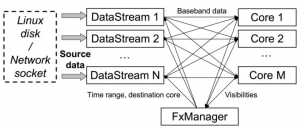Staff: M. Stagni, M. Nanni
The VLBI Correlator is the software tool that allows data synchronization from antennas hundreds or thousands miles apart in order to operate as a single radio telescope with a resolution of a few mm arcseconds.
The VLBI-IT DiFX software correlator was installed in 2012 during the FP7-NEXPReS EU grant, whose aim was to investigate fast data transmission protocols over large bandwidth networks (10 GBit/s) and storage architectures capable to record data streams up to 4 Gbit/s. The DiFX software correlator was also the ideal tool to test the development of the Digital Base Band Converter (DBBC) and run the first interferometric tests with the SRT.

A. DiFX software correlator architecture
The parallel computer architecture where the DiFX software (Deller et al. 2007 – manuals) is made of 4 computing and storage nodes (colloquially called Tanks) connected via a 40 Gbit/s Infiniband network. Every node has an average storage capacity of 100 TB to hold the raw incoming data from the antennas.
Each node is connected to the GARR network using a dedicated 10 Gbit/s network. The peak capability of the system is to correlate in real time 4 antennas streaming data at 2 Gbit/s. However the usual operating mode is to save the raw data onto the storage space in order to prevent errors and have the possibility to correlate again a number of times.
At present the correlator is actively correlating data from INAF antennas (Medicina, Noto and SRT radio telescopes) and the ASI Center in Matera. It is not unusual that also other international antennas (from Spain, Poland, Korea, SouthAfrica, etc.) join in the experiments both for astronomy and geodesy. Other experiments also involve time and frequency analysis to compare atomic clocks time reference disseminated over optical fiber at the antennas (for more info see here and here).
Credits
Main button: INAF-IRA
Figure A: Deller et al. 2007, PASP 119 318, “DiFX: A Software Correlator for Very Long Baseline Interferometry Using Multiprocessor Computing Environments”, Figure 1. DOI: 10.1086/513572
